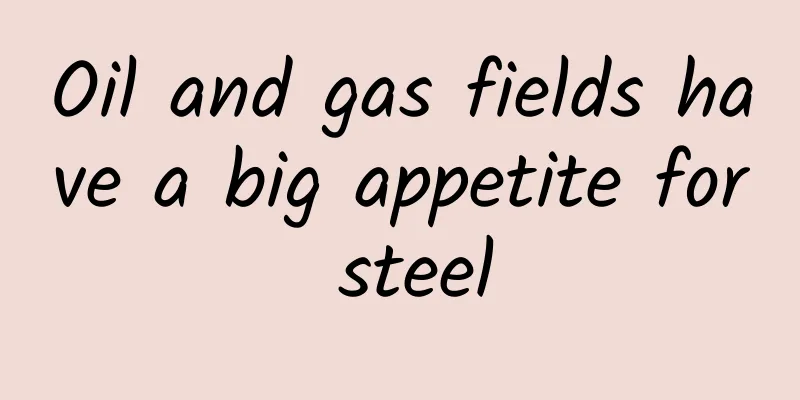Oil and gas fields have a big appetite for steel

|
Everyone on earth knows that in order to extract the oil and natural gas stored in the earth's crust, you need to drill very deep holes and penetrate hundreds or even thousands of meters of rock layers to obtain the treasures that people cannot live without. But do you know that oil and natural gas are produced at the cost of high-quality steel pipes? A brief description of the general process of well construction will make it clear that this is not a fallacy. Take oil drilling on land as an example. Not to mention the huge rigs and drilling tools, the borehole that reaches the oil reservoir is a big hole that "swallows" steel. In order to prevent the uneven soft and hard well wall from collapsing, seamless steel pipes with high compression, tensile and corrosion resistance must first be lowered into the wellbore that reaches the oil and gas layer to keep it unobstructed. In other words, the deeper the wellbore, the longer the steel pipe must be. The diameter from top to bottom is from thick to thin, and the pipe wall is from thick to thin. In order to prevent blowout accidents during drilling, multiple steel pipes are sometimes lowered to ensure safety. This kind of pipe permanently sealed in the well with cement is called casing. Domestic casing for oil and gas fields is manufactured according to the API standard formulated by the American Society of Petroleum Engineers and is divided into several steel grades. The commonly used ordinary J-55 casing has a light green ring mark, and the N-80 casing with a higher strength level has a red ring mark. According to the theoretical mass calculation of a nominal diameter of 140 mm, a wall thickness of 7~10 mm, and a threaded coupling for each 10-meter long pipe, the cumulative mass of casing required to be lowered to drill a well depth of 1 kilometer is at least 30 tons. There are not many oil and gas fields discovered in my country with a burial depth of less than 1,000 meters. Most of them need to drill medium-deep wells of 1,500~2,500 meters to extract oil and gas. The depth of gas wells in the Tarim Basin in Xinjiang has reached 8,000 meters. It is conceivable that at least tens to hundreds of tons of casing need to be lowered to satisfy the "appetite" of a deep well. The wellbore protected by casing has been built, but it cannot be used directly to produce oil and gas. In order to guide the oil and gas flow from the formation to the ground, a liner carrying a variety of downhole tools must be lowered into the casing to artificially control the oil and gas production to a reasonable range. This liner, which is smaller than the inner diameter of the casing, is not fixed and can be taken out at any time to replace the downhole tools carried for maintenance. Because it is the channel for oil and gas flow production, it is called oil pipe in the industry. Usually, a seamless steel pipe with an outer diameter of 73 mm and threaded connection is hung in a casing with a nominal diameter of 140 mm as the only way for oil and gas to flow out of the wellbore. Domestic oil and gas field special oil pipes are also manufactured in accordance with the internationally accepted API standards. According to the theoretical mass calculation of one threaded coupling per 8 meters, the cumulative mass of the oil pipe with a depth of about 1 km is about 9 tons. If the wellbore is particularly deep, a high-strength oil pipe with a larger diameter and thickness can be hung under the condition that the inner diameter of the casing allows. The depth of the well is determined by the strength of the pipe body and the connecting thread, and the maximum limit can reach about 50 tons. With protective casing and hanging oil pipes, a simple gas well can be put into production. This is not the case with oil wells. Since they cannot rely on the consumption of natural energy to produce oil by self-flowing for a long time, when the oil flow cannot rise to the ground by itself, it is necessary to install machinery to provide lifting power, and two types of deep well pumps with or without rods must be lowered into the oil pipe. The most common rod pump oil production machinery in the oil field is a pumping unit that reciprocates up and down at the wellhead. By suspending a slender steel rod, it drives the deep well pump that sinks below the liquid surface to pump and work. This rod-shaped downhole object connected by threads is called a sucker rod, with a diameter of 16~25 mm, and the maximum outer diameter of the coupling does not exceed 36 mm, so that it can move freely up and down in the oil pipe with an inner diameter of 62 mm. Taking the pump hanging depth of 900 meters, using a nominal diameter of 22 mm sucker rod, and connecting a tubular pump with an inner diameter of 44 mm as an example, the cumulative mass lowered into the well is about 3 tons. If the weight of the oil pump installed on the ground, which is about 10 tons, is added, the total mass of this mechanical lifting system is at least 15 tons. The above is only the most basic amount of steel required to build an oil and gas well. If a medium-sized oil and gas field with an annual output of one million tons is built, hundreds of production wells are often needed. A large oil and gas field with an annual output of tens of millions of tons needs to drill tens of thousands of production wells of varying depths. Excluding the various pipelines for transporting oil, gas and water laid horizontally on the ground, the total number of pipes and rods drilled vertically underground that are invisible will be a staggering number. As we all know, the French used only 7,000 tons of steel to build the 324-meter-high Eiffel Tower. If the steel used for the pipes, rods, machines and pumps buried underground in a medium-sized oil and gas field is added up, it is enough to build dozens or even hundreds of Eiffel Towers. Therefore, it is no exaggeration to say that oil and gas fields are monsters that devour a large amount of steel. Because a large amount of steel is hidden underground and cannot be seen, people who do not know the truth often have the illusion that developing oil and gas fields is just drilling oil wells vertically and laying pipelines horizontally, and they do not know that each production well is an oil and gas flow channel built with dozens or even hundreds of tons of steel. Only by solving this confusing puzzle can we gain a comprehensive understanding of the oil and gas fields. Author: Gong Ke |
Recommend
How to attract the core users you want!
The core users we are talking about probably refe...
If you don’t pick up “garbage” in autumn, your whole year on earth will be in vain!
In autumn, we see a lot of fallen leaves, fruits,...
How to find a foothold when taking over a brand new business operation? Here are 6 ways
When I was about to get off work last night, a co...
The sunglasses you wear everyday don’t work when you drive?
In summer, many people go out fully armed and wra...
How to post videos on Douyin and become popular?
There is no doubt that Tik Tok is so popular that...
Why does this fish have a "human face"? Watch it for three seconds and see who can hold back their laughter...
Without further ado, here are the pictures! Image...
The next decade: changes and prospects of mobile communications
What are we talking about when we talk about the ...
White is not the base color of the earth!
As my country's urbanization and modernizatio...
Do ads harm user experience? 4 tips to tell you how to break it!
Whether it is the BAT giants, super media such as ...
Fanchen smart electric mask meets EU testing standards and has CE certification and RoHS certification
According to real-time data from the global COVID...
Science poster: How does an infrared forehead thermometer measure body temperature?
Science poster: How does an infrared forehead the...
Zhongguancun Entrepreneurship Street: From "Coffee Shop" to "Industry Faction"
Beijing's "Zhongguancun Startup Street&q...
[Community Taobao Affiliate Incubation] A detailed explanation of Taobao Affiliate sales and monetization methods
Speaking of community Taobao, this is actually th...
Gao Qiqiang is not the only one who can use the "Art of War"
Since the broadcast of "Kuang Bi", &quo...
The most powerful telescope in the Northern Hemisphere is now online! What can you see through it?
The universe is vast and boundless, and celestial...









